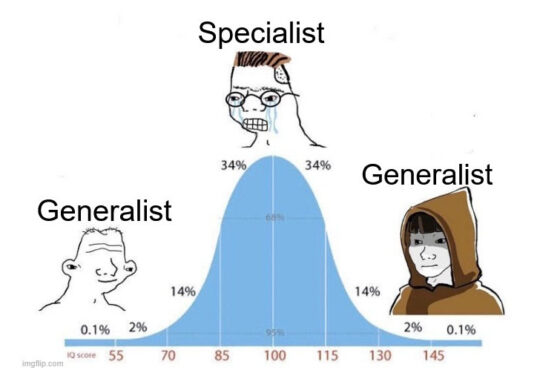
Beyond Networking: Building a Social Portfolio for Success and Fulfillment
The Problem with Running Your Relationships on Autopilot
Most people spend more time planning their next vacation than they do planning their relationships.
We drift into friendships by proximity: coworkers, neighbors, classmates, whoever happens to be around. We maintain bonds by inertia, keeping up with old friends even if they no longer align with who we’re becoming. We treat “being social” as something that just happens, not something we intentionally design.
And the cost is enormous.
The wrong relationships waste your energy, drain your motivation, and subtly steer your life in directions you don’t want to go. The right ones unlock opportunities, challenge you to grow, and create stability when everything else feels uncertain.
The self-help world has obsessed over habits, routines, and productivity hacks, but the truth is:
Your relationships determine your trajectory more than any app, planner, or supplement ever will.
This is where social strategy comes in.
Not just networking. Not just “being social.”
But intentional relationship design, choosing, cultivating, and managing your friendships and alliances the way an investor manages a portfolio.
What Happens When You Don’t Have a Social Strategy
If you don’t design your relationships, you end up with:
- Autopilot alliances: Friends you may have outgrown in certain areas, but you keep them because you’ve known them “forever.” They still hold value, loyalty, history, and shared memories, even if they’re no longer the go-to for growth or advice.
- One-dimensional networks: A circle that’s fun to party with but useless for growth. Or a professional network that’s great for career moves but leaves you lonely on the weekends.
- Energy leaks: People who constantly vent, brag, or compete, leaving you drained instead of fulfilled.
I’ve felt this personally.
One of my friends is fantastic to joke around with. If I want a wild night, he’s my first call. But the second I bring up a problem, he turns it into a stage for his own life. Instead of listening, he brags. Instead of giving advice, he tells me to “just be more like him.” Same with goals, if I share one, he hijacks the conversation to boast about his accomplishments.
I don’t hate him. I just learned not to go to him for advice or accountability. He’s a fun friend, not a growth friend.
Without that realization, I’d keep walking away from those conversations frustrated and unsupported. With it, I know where he fits in my relationship portfolio.
Most people never make that distinction. They expect every friend to be good at everything. And when they’re not, they either get disappointed… or they cut the person out entirely.
But the truth is: friendships are like tools. A hammer isn’t bad because it can’t cut wood — it’s just not a saw.
Solution: Designing Your Social Strategy
Let’s reframe relationships as a system.
If wealth is built by financial capital, and health is built by physical capital, then your life is built by social capital.
Like any form of capital, it compounds if you manage it wisely, and leaks away if you ignore it.
Here are the core principles of social strategy:
1. The Diversified Friendship Portfolio
In investing, putting all your money in one asset class is risky. You diversify to maximize returns while minimizing volatility.
Friendships work the same way.
A well-rounded relationship portfolio includes:
- High-status friends (leverage and learning)
Think of Benjamin Franklin. He strategically cultivated relationships with scientists, politicians, and business leaders far above his station. Those alliances gave him influence and knowledge he never could have gained alone. High-status friends elevate you. They show you what’s possible and connect you to opportunities. - Peer friends (stability and solidarity)
Look at the “Inklings,” the writing group that included C.S. Lewis and J.R.R. Tolkien. They weren’t mentoring each other from above; they were peers, sharpening one another through mutual feedback and accountability. Peers provide a reality check. They celebrate your wins, call you on your excuses, and grow alongside you. - Lower-status friends (teaching and contribution)
Marcus Aurelius, emperor of Rome, mentored young men who served him, not because he needed them, but because teaching sharpened his own philosophy. Investing in those below you cements your knowledge, keeps you humble, and creates loyalty.
When you diversify, you cover all bases: challenge, support, and contribution. Without diversification, you risk lopsided growth, a circle that’s fun but shallow, or inspiring but intimidating.
2. Relationship Strategies by Personality Type
Not all strategies work for all people. Your personality shapes how you should invest in relationships.
- Extroverts: Great at building breadth. Your risk is shallowness. Strategy: consciously deepen a select few bonds.
- Introverts: Great at depth. Your risk is isolation. Strategy: focus on fewer, high-quality bonds, but use structured groups (book clubs, classes, projects) to expand reach.
- Neurotic / Cautious types: Reliable, detail-oriented, loyal. Your risk is overthinking. Strategy: use reliability as your trust signal. Be the anchor people can count on.
- Agreeable / Empathetic types: Supportive, warm, approachable. Your risk is overextending. Strategy: set boundaries and invest in reciprocal bonds.
- Dominant / High-status types: Natural leaders. Your risk is intimidation. Strategy: balance authority with generosity — mentor others, don’t just command.
- Conscientious types: Highly competent. Your risk is invisibility. Strategy: make contributions visible, share credit and let others see your value.
Personality is not a barrier, it’s an edge. The key is to know your natural assets, hedge your risks, and invest accordingly.
3. The Reciprocity Sequence: How to Build Stronger Bonds
Help is the currency of the friendship economy. But not all help is equal.
Here’s the hierarchy:
- Repaying help → strongest effect. Proves reliability, fairness, and trustworthiness.
- Receiving help → surprisingly strong. The Benjamin Franklin Effect: when someone helps you, they like you more because they justify the effort.
- Giving help → still positive, but weaker. If done poorly, it creates imbalance or resentment.
The optimal sequence:
- Ask for help → let them invest in you.
- Repay that help → prove you’re trustworthy.
- Offer help later → cement your status as high-value.
This rhythm keeps relationships balanced, fair, and sticky.
4. Sharing Needs Strategically
Too many people try to look “low-maintenance.” They never ask for anything. But that robs others of the chance to invest.
Others over-share, turning every interaction into a therapy session. That makes them emotionally expensive to be around.
The strategy is balance: share needs, but frame them constructively.
- Invite collaboration: “You’re good at spotting blind spots, can I run this by you?”
- Show progress: “I’m working on X, and one thing that would help is Y.”
- Highlight trust: “I don’t usually share this, but I trust you with it.”
- Keep it finite: make clear asks, not endless obligations.
When you ask well, people feel valued, not burdened.
5. Be Clear About the Root of Your Needs
Vagueness wastes social energy.
If you say “I’m stressed,” people don’t know how to help. They nod sympathetically and change the subject.
If you say, “I’m behind because I keep overcommitting — I need help prioritizing,” now they have a clear entry point.
Root clarity does three things:
- Makes their help effective.
- Signals trust and vulnerability.
- Strengthens the bond through collaboration.
Vague needs are like leaking coins in the friendship economy. Root needs are targeted deposits that grow the relationship.
6. Keep Relationship Files
If your friendships are assets, track them like one.
I keep informal “files” on friends: what they’re good at, what they value, and where their limits are.
- Friend A: great for parties and jokes → perfect for fun and stress relief.
- Weakness: dismissive when I talk about goals → not the right person for advice.
This isn’t cynical, it’s strategic. You don’t expect your dentist to do your taxes. Why expect one friend to be your entertainer, therapist, and mentor all at once?
Benefits of relationship files:
- Know who to turn to for different needs.
- Avoid repeated disappointment.
- Show up better by remembering what matters to them.
This is portfolio management in practice. You’re not judging friends; you’re using them for what they’re best at, while still appreciating them for who they are.
The Social Strategy Mindset
When you stop drifting and start designing, you stop being at the mercy of whoever happens to walk into your life. You start cultivating alliances that multiply your opportunities, protect your well-being, and make your life richer in every sense.
Key Principles
- Intentional relationship design is deeper than networking and broader than “being social.”
- Diversify your friendship portfolio: high-status, peers, and lower-status.
- Leverage your personality as a strength, not a weakness.
- Follow the reciprocity sequence: ask → repay → offer.
- Share needs strategically, enough to invite investment, not enough to drain.
- Clarify root problems so people can actually help.
- Keep relationship files, track needs, strengths, and limits.
Key Takeaways
- Your life trajectory is determined more by relationships than habits or hacks.
- Relationships compound like capital if you invest wisely.
- Every personality type has a viable strategy for thriving socially.
- Reciprocity and need-sharing, done right, create durable bonds.
- Managing friendships as a portfolio
The people who rise, in history, business, or just in life satisfaction, don’t leave relationships to chance. They design them with the same care they design their careers, health, and wealth.
Thanks for reading my stuff,
MJ




